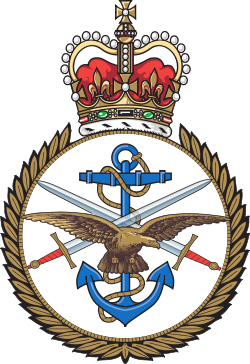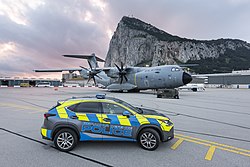| British Forces Gibraltar | |
|---|---|
 British Forces Tri-Service badge | |
| Active | April 1992–current Flag Officer, Gibraltar, 1946-1992 |
| Country | Gibraltar |
| Branch | Strategic Command [1] |
| Part of | Strategic Command. Subordinate to Director of Overseas Bases. |
| Headquarters | Devil's Tower Camp |
| Anniversaries | Battle of Trafalgar |
| Commanders | |
| Commander of British Forces Gibraltar | Commodore Cameron Douglas |
| Commanding Officer, Royal Gibraltar Regiment | Lieutenant Colonel Ross Major Magee |
| Commanding Officer, Gibraltar Squadron | Lieutenant Commander Kieran Kingy Kingston |
| Commanding RAF Gibraltar | Wing Commander Thomas Harvey |
British Forces Gibraltar constitute those elements of the British Armed Forces stationed in the British overseas territory of Gibraltar. Gibraltar is used primarily as a training area, thanks to its good climate and rocky terrain, and as a stopover for aircraft and ships en route to and from deployments East of Suez or in Africa.
Contents
- History
- Command
- Facilities
- Devil's Tower Camp
- HM Dockyard, Gibraltar
- RAF Gibraltar
- King’s Lines Oil Fuel Depot
- Windmill Hill
- Permanent units
- Previous commanders
- Senior Officer, Gibraltar
- Flag Officer, Gibraltar
- Flag Officer, Gibraltar and North Atlantic
- Flag Officer, Gibraltar and Mediterranean Approaches
- Flag Officer, Gibraltar 2
- Commander British Forces, Gibraltar
- See also
- Notes
- External links
British Forces Gibraltar as a formation was established in mid-1992 after the last Royal Navy-lead commander, Rear Admiral Geoffrey Biggs, Flag Officer Gibraltar, hauled down his flag. Thereafter the new command took on a more tri-service character.


